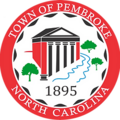Pembroke, North Carolina | |
|---|---|
 Town of Pembroke welcome sign. "Town. Tribe. University." | |
| Nickname: Home of the Tribe | |
| Coordinates: 34°40′36″N79°11′36″W / 34.67667°N 79.19333°W | |
| Country | United States |
| State | North Carolina |
| County | Robeson |
| Incorporated | 1895 [1] |
| Named after | Pembroke Jones [1] |
| Government | |
| • Mayor | Charles Gregory Cummings |
| Area | |
• Total | 3.18 sq mi (8.23 km2) |
| • Land | 3.18 sq mi (8.23 km2) |
| • Water | 0 sq mi (0.00 km2) |
| Elevation | 171 ft (52 m) |
| Population (2020) | |
• Total | 2,823 |
| • Density | 888.1/sq mi (342.88/km2) |
| Time zone | UTC-5 (Eastern (EST)) |
| • Summer (DST) | UTC-4 (EDT) |
| ZIP code | 28372 |
| Area codes | 910, 472 |
| FIPS code | 37-51080 [4] |
| GNIS feature ID | 2407093 [3] |
| Website | www |
Pembroke is a town in Robeson County, North Carolina, United States. It is about 90 miles inland and northwest from the Atlantic Coast. The population was 2,823 at the 2020 census. The town is the seat of the state-recognized Lumbee Tribe of North Carolina, as well as the home of the University of North Carolina at Pembroke.




